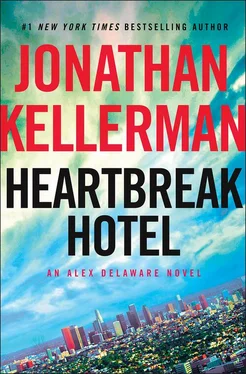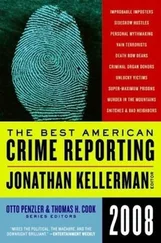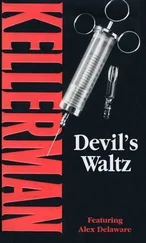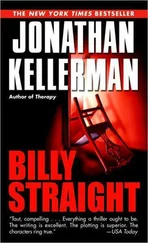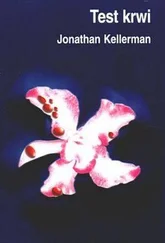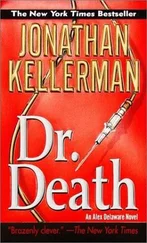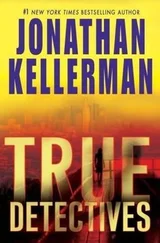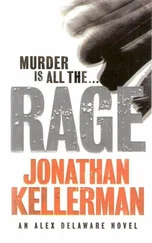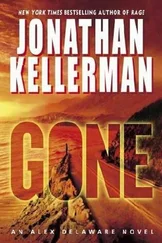She studied me. “Sounds like you’re into the in humanities. Maybe we’ve got something in common.”
I opened the envelope in my car.
Generous receptacle, sparse contents.
Maxine Driver had included the same list I’d pulled off the Internet, with Leroy Hoke’s name circled in yellow. Next came photocopies of Hoke’s black-and-white San Quentin mugshot and data card. The photo showed a fair-haired man with dark brooding eyes. The hair was wavy and piled high and the stats clarified the color. Red. Lighter patches at the temples that were probably gray; notable freckles on forehead and cheeks.
Five-eleven, one hundred forty-six pounds fit the bony, knife-blade visage glaring at the prison photographer. Lantern jaw, off-kilter boxer’s nose, narrow mouth, skimpy unamused lips. The eyes, listed as Black, were narrow and accusing, set deeply and shadowed by a shelf of brow.
A scar ran diagonally across a meaty cleft chin. One ear was set higher than the other, protruded a bit and was missing a section of lobe.
Despite less-than-ideal parts, a surprising outcome for the whole. Not a bad-looking guy.
The card listed scars on chin, arms, back, and buttocks. No tattoos, no warnings of violent tendencies, just a notation that the prisoner had led a “criminal enterprise.”
Aliases: Oklahoma Red, Tulsa Red, Double-L, Okie King, Sir “H,” Monark.
The remaining contents consisted of two sheets of paper containing photocopied snippets from articles in the L.A. Herald-Express, the Mirror, and the Times, again with Hoke’s name accented in yellow.
Each clipping reported on unsolved crimes, beginning with a broad-daylight armored car robbery on Sixth Street, downtown, that remained “mysterious” after a year of investigation. Police had looked into “criminal gangs led by ‘Italians’ and other mobsters” including Mickey Cohen, L. L. “Tulsa Red” Hoke, and “colored kingpin Julius ‘Papa Blue’ Carpentier.”
Similar outcomes were detailed for a smash-and-grab jewel theft at a posh store in Pasadena, bank robberies in Culver City, Mid-Wilshire, and San Gabriel, and the “enigmatic disappearance” of a truckload of furs intended for Bullocks Wilshire.
The final felony was another jewel theft in 1938, this one in Beverly Hills, accomplished in the dead of night.
The wall separating Elena’s Dress Shoppe on Rodeo Drive from Frederick LaPlante Fine Jewelers had been breached, probably with hand tools. The burglary netted “countless bracelets, necklaces and rings and other faceted female finery.” An unconfirmed rumor said some of the glitz had been set aside for the tenth annual Oscars gala, held at the Biltmore Hotel.
For that one, “publicity-shy” Hoke was described as a “serious person of interest,” then quoted as “denying his involvement unequivocally through a spokesman and offering an ironclad alibi: At the time of the robbery, he’d been in a back booth at Perino’s, “dining in full view of numerous citizens, including society notables.”
That claim, the Mirror was happy to add, “was confirmed by our journalists.”
No mention of Hoke’s suspected ownership of the Aventura Hotel.
No photos of Monark with anyone, let alone a diminutive young moll named Midget.
I drove home and worked the computer, using Driver’s information. Nothing, until I came upon a series of photographs commemorating Perino’s sixty-four-year run as an haute-cuisine hangout in 1940.
A black-and-white photo spanned three groups of diners. Film folk on both sides, the reason the shot had been archived.
It was the middle banquette that interested me.
In the center, a fair-haired, dark-eyed ectomorph in a broad-shouldered tuxedo, with a half-eaten wedge of cream pie in front of him, nursed what looked to be a cup of coffee. To his left was a hulking, pug-faced man twice Leroy Hoke’s width, his beverage a crystal stein of foam-topped beer.
To Hoke’s right sat a tiny blond beauty in her twenties. Nestled under the gangster’s arm, delicate fingers resting near a Martini glass.
Pixie face, big eyes, darkly rouged lips. A black spaghetti-strap dress set off pale shoulders and a swan neck. Young enough to be Hoke’s daughter but nothing daughterly about the mischievous half smile she beamed up at him.
Nothing fatherly about his hand dangling over her shoulder, a pinkie looped languidly around a strap.
No way to be certain she was a young Thalia. Nothing said she wasn’t.
I studied the picture, thought I found familiarity in the huge, lively eyes, the subtle amusement.
My bet would be Yes. I’d take almost any odds.
I stayed at my desk for another hour and a half, searching for info on any crimes linked to Hoke. No coverage of the earlier felonies in the Mirror piece, but the Frederick LaPlante robbery had been a big enough deal to merit ink in all four L.A. papers. Same story as the Mirror, nearly word for word, which meant regurgitation of an LAPD press release.
Researching the jewelry store brought up a story about its opening four years prior to the heist, in The Beverly Hills Monitor, a free weekly, now defunct, with a flexible attitude toward syntax and style. The font looked as if it had been typed and mimeographed.
Fine European Jewels Flock To The Verdant Hills of Beverly.
There are considerable admirations of the gifts and talents of Count Frederick Charles Normandy Etienne De LaPlante, a post-World War I emigre from Paris, France, who has dazzled us constantly and most consistently due to his esteemed history as a noted desinatrace de bijoux who has formerly and prominently consulted to Cartier and other Gallic geniuses of glamour. Thus acquiring first-hand expert knowledge of both exquisitely rarified items and also Olde Worlde haute jewelry — artistry at the most demanding and discerning level.
Included among the Count’s recent treasured acquisitions now brought to our temperate California shores under cover of discretion and taste, are a more than 15 karat flawless diamond said to have been worn by Marie Antoinette within hours of her decapitation at the hand of bloodthirsty, merciless revolters, also the massive Inca Goddess Emerald from the Andes of Peru presented in its original guanaco-lined case, an animal that only exists at the most alpine level of the Ande mountains. Eyes have glistened viewing so many others including the 57 karat Wine of the Nile ruby, said to have been excavated by daring explorers and orientalism near an ancient Egyptian pyramid.
But these are not all, Count LaPlante’s sanctum of fabulous facets has items to satisfy any level of connoisseurship.
A headshot at the top portrayed a wax-mustachioed dead ringer for Errol Flynn, if Flynn had put on midlife weight.
I keyworded LaPlante’s full title and name, found an article dated six years after the heist in the New York Post.
This one was anything but puff:
Fake-Frog Scamster Unveiled as Count-Me-Out Count
A phony French nobleman palming himself off as an art consultant to the rich, famous, and gullible, has been revealed as an all-American con-man who’s coasted for years on the stupidity of the moneyed set.
Fred Bullard Drancy, born in a working class section of Boston, and convicted as a young man of numerous shams, swindles and scams, managed to go almost clean for a few years when he worked as a delivery driver for Shreve, Crump and Lowe in Beantown. A few years later, he’d moved to California, was palming himself off as a Gallic hoo-hah with the unwieldy moniker Count Frederick Normandy De LaPlante.
Читать дальше
